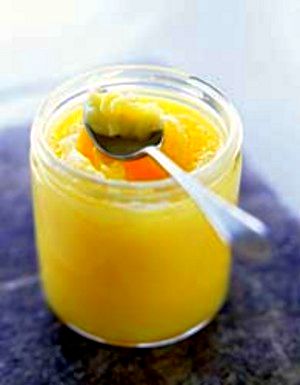
Ghee-Clarified Butter
For years, clarified butter has been a part of traditional Indian cuisine but this virtuous cooking medium ran out of favor with fitness experts and nutrition specialists as it is high in saturated fat and cholesterol and often the cause of expanding waistlines and obesity.
However, new trends are now emerging, in a way, reinventing tradition.
Ayurveda experts are backing ghee for its vitamins, longer shelf-life and immunity-boosting qualities.
Immunity boosterThe word ghee is derived from the Sanskrit word, ghrita, meaning sprinkled. "In ayurvedic medicine, ghee is believed to strengthen the ojas, our vital energy cushion, the root of our well-being and immunity.... It is said to help stimulate the healthy flow of fluids throughout the body. It is also an important rejuvenating tonic for the mind, brain and nervous system," says US-based nutrition expert, Jonny Bowden, author of
The 150 Healthiest Foods on Earth.One of the oldest cooking mediums, ghee has a high smoking point, is shelf-stable and is rich in calcium. Medicated ghee, infused with herbs, is also available in the market. "Grass-fed cow's ghee is a natural anti-oxidant and conjugated linoleic acids or CLA," says Agarwal. But he cautions, "Do not burn ghee when you start cooking. Don't overheat ghee and by and large, reduce the intake of fried foods." Another important taboo: Do not use rancid, old, foul-smelling ghee." Besides its medicinal value, ghee also has a smoky flavor that enhances taste in dishes cooked in it.
An ancient Carvaka saying sums up the importance of ghee: "Yaavat jeevet, sukham jeevet rinam kritva, ghritam pibet" - "As long as you live, live happily, beg, borrow or steal, but relish ghee." In Indian tradition, ghee is used not only as a cooking medium, but it is also a key ingredient in Vedic rites and rituals and is considered a symbol of prosperity.
It's also used for lighting diyas, worshipping and bathing idols and in Hindu marriage and cremation rituals.
Key is moderationGhee may be the favorite of ayurveda experts, but sceptics, point to lack of mega trials and research to back ghee as a super food. "It's also a source of cholesterol. Those who lead an active lifestyle and exercise at least five days a week can have ghee. If you suffer from chronic diseases such as diabetes and hypertension or have cardio-vascular problems, consult your doctor or dietician on the amount of ghee you can take every day," says Sonia Kakar, country director, Project Hope, an NGO that works with diabetics and heart patients. Our body requires certain amounts of saturated fat to function smoothly and ghee is much better than oils laced with trans fats. "We need 1:1:1 ratio of sat fat, polyunsaturated fatty acids and monounsaturated fatty acids. So moderation is the key word in the consumption of ghee," says Ritika Samaddar, chief dietician, Max Healthcare. So when you reach out for that dabba of nice-smelling ghee, remember it is good only in small quantities. Doctors, suggest no more than one to two teaspoons per day per person.
Comment: The article states 'fitness experts and nutrition specialists state ghee is high in saturated fat and cholesterol and is often the cause of expanding waistlines and obesity.' Read the following article to understand how we have been lied to about the benefits of saturated fats: The Big Lie: "Saturated Fats Are Bad For You" - from the article: Saturated Fats benefit overall health and wellness, for more information on the health benefits of saturated fats read the following articles:
7 Reasons to Eat More Saturated Fat
Saturated Fat is Good for You
Higher saturated fat intakes found to be associated with a reduced risk of dying from cardiovascular disease
Saturated Fat and Heart Disease
What if It's All Been a Big Fat Lie?
Why high fat diets are not fattening
Wrongly Convicted? The Case for Saturated Fat
From the article: